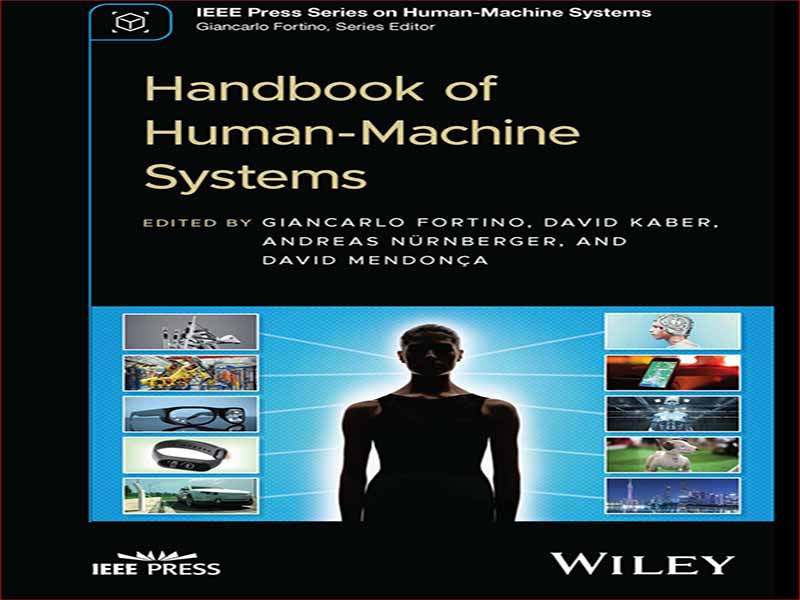- عنوان: Handbook of Human-Machine Systems
- نویسنده: Giancarlo Fortino
- حوزه: طراحی سیستم
- سال انتشار: 2023
- تعداد صفحه: 531
- زبان اصلی: انگلیسی
- نوع فایل: pdf
- حجم فایل: 16.0 مگابایت
سیستم های انسان و ماشین (HMS) به سیستم های یکپارچه ای اطلاق می شود که در آن عملکرد اپراتورهای انسانی و ماشین ها ترکیب می شود. این سیستم ها را می توان به عنوان یک موجودیت یکپارچه که با محیط خارجی در تعامل است در نظر گرفت. در HMS، انسانها و ماشینها با هم کار میکنند و از قابلیتهای مربوطه خود برای دستیابی به اهداف خاص یا انجام وظایف استفاده میکنند. HMS می تواند اشکال مختلفی داشته باشد و در حوزه های مختلف وجود داشته باشد. به عنوان مثال می توان به سیستم های کنترل پرواز هواپیما، سیستم های اتوماسیون صنعتی، سیستم های روباتیک پزشکی و حتی دستیاران مجازی یا چت بات ها اشاره کرد. در این سیستم ها، انسان ها توانایی های شناختی، مهارت های تصمیم گیری و تخصص خود را به اشتراک می گذارند، در حالی که ماشین ها قدرت محاسباتی، اتوماسیون و دقت را ارائه می دهند. ادغام انسان و ماشین در HMS از طریق سطوح مختلف اتوماسیون قابل دستیابی است. این می تواند از سیستم های کاملاً دستی، که در آن انسان ها مسئول همه وظایف هستند، تا سیستم های نیمه خودکار، که در آن ماشین ها به انسان در عملکردهای خاص کمک می کنند، تا سیستم های کاملاً مستقل، که در آن ماشین ها اکثر وظایف را با کمترین مداخله انسانی بر عهده می گیرند، متغیر باشد. رشته مهندسی HMS بر درک، طراحی و بهینه سازی این سیستم های یکپارچه متمرکز است. این شامل مطالعه تواناییها، محدودیتها و تعاملات انسانی و همچنین توسعه فناوریها و رابطهایی است که همکاری مؤثر بین انسانها و ماشینها را تسهیل میکند. هدف ایجاد سیستم هایی است که عملکرد انسان را افزایش می دهد، کارایی را بهبود می بخشد و ایمنی و قابلیت اطمینان را در زمینه های عملیاتی مختلف تضمین می کند. به طور کلی، HMS نشاندهنده همافزایی بین انسان و ماشین است و از نقاط قوت هر دو برای ایجاد سیستمهای قدرتمند و کارآمد استفاده میکند که میتواند وظایف و چالشهای پیچیده را در حوزههای مختلف برطرف کند. هدف این کتاب این است که مانیفست تحقیق و توسعه HMS باشد، که آخرین هنر را در این زمینه، همچنین با استفاده از موارد استفاده نماینده، و همچنین چالشهای تحقیقاتی آینده، ترسیم میکند. این در هفت حوزه سازماندهی شده است که تمام جنبه های HMS را پوشش می دهد: رابط ها و سیستم های مغز و ماشین (BMIS)، سیستم ها و برنامه های هوشمند مشترک (CISA)، فناوری همراه (CT)، تعامل انسان و هوش مصنوعی و محاسبات و مهندسی شناختی (HAICCE)، مهندسی عوامل انسانی (HFE)، محاسبات و سیستمهای تعاملی و پوشیدنی (IWCS)، و فناوریهای ترکیبی (HT). علاوه بر فصل مقدمه، این کتاب شامل 36 فصل می باشد که در زمینه های فوق الذکر مورد بررسی قرار گرفته است.
فصل های 2 تا 6 مربوط به BMIS هستند و به روش ها و فن آوری های BCI (رابط مغز و کامپیوتر) می پردازند. به طور خاص، فصل 2 پیشینه ای کلی در مورد BCI ارائه می دهد، فصل 3 بر نوروفیدبک عاطفی فعال شده با BCI تمرکز دارد، فصل 4 انطباق تکنیک های BCI را برای کودکانی که با ناتوانی جسمی شدید زندگی می کنند معرفی می کند، فصل 5 کاربرد BCI را برای کنترل هواپیماهای بدون سرنشین پیشنهاد می کند، و فصل 6 از BCI برای کنترل از راه دور روبات ها به افراد دارای معلولیت استفاده می کند. فصلهای 7 تا 13 به CISA اشاره میکنند و به پیشرفتها در توسعه پایههای علمی و مهندسی، فناوریهای نوآورانه و راهحلهای فناوری و سیستمهای هوشمند مشارکتی مبتنی بر داده میپردازند. به طور خاص، فصل 7 بر روی سیستم های اجتماعی انسان-ماشین مانند تیم سازی انسان-ماشین تمرکز دارد، فصل 8 مکانیسم هایی را برای فعال کردن تعامل انسان-ربات معرفی می کند، فصل 9 فرآیندهای مشارکتی انسان محور را بررسی می کند که توسط واحدهای انسان و ماشین فعال می شوند، فصل 10 چارچوب های نظری را مرور می کند. و پیشرفتهای اخیر در تحقیق و توسعه شفافیت انسان و ماشین، فصل 11 مروری بر فناوری و روشهای موجود برای توسعه رابطهای مکالمه انسان و ماشین ارائه میکند، فصل 12 یک استراتژی و روش پایدار برای سیستمهای پیچیده اجتماعی – فنی پیشنهاد میکند، و فصل 13 پارادایم محاسباتی جدید ادغام انسان و ماشین فصلهای 14 تا 17 به CT تعلق دارند و به تحقیقات فرا رشتهای در زمینههایی مانند علوم کامپیوتر و هوش مصنوعی، علوم شناختی، مهندسی، روانشناسی و زیستشناسی عصبی میپردازند. به طور خاص، فصل 14 برخی جنبه های پس زمینه CT را مرور می کند، فصل 15 بر روی ربات های کمک حرکتی از نوع رولاتور تمرکز می کند و پلت فرم ها و عملکردهای آنها را مرور می کند، فصل 16 بر مفهوم نوآورانه ربات های عاطفی پوشیدنی، نمونه دیگری از CT، و فصل 17 تمرکز می کند. به بررسی آخرین هنر در تعامل بصری انسان و رایانه در وسایل نقلیه هوشمند می پردازد. فصلهای 18 تا 22 بر موضوعات مهم در HAICCE و توجه به شناخت انسان در طراحیهای سیستم هوشمند/AI یا/و توسعه الگوریتمهای هوش مصنوعی، فناوری، روشها برای انسانها تمرکز دارند. به طور خاص، فصل 18 به مشکل همگام سازی بین اعمال انسان و ربات می پردازد، فصل 19 مرزهای جدید سیستم های هوشمند و توانایی آنها برای وارد شدن به همکاری پیشرفته با انسان ها و سایر سیستم های مصنوعی کم و بیش هوشمند را بررسی می کند، فصل 20 بر رمزگشایی احساسی کاربر تمرکز دارد. عبارات به عنوان یک عامل مهم تأثیرگذار بر تعامل بین انسان ها و دستیاران مجازی، فصل 21 لبه محاسباتی هوشمند را بررسی می کند و فصل 22 به موضوع مهم اجرای آگاهی از زمینه در وسایل نقلیه خودران می پردازد. فصلهای 23 تا 28 به HFE و بر پیشرفتهای تئوری و عملی مربوط به تعامل انسان با عوامل هوشمند در محیطهای مختلف تمرکز دارند. به طور خاص، فصل 23 یک بررسی سیستماتیک در مورد سیستم های کمکی اپراتور ارائه می دهد، فصل 24 رویکردهای مدل سازی عملکرد شناختی در حوزه مهندسی سیستم های انسانی را بررسی می کند، فصل 25 به سیستم های کمک راننده پیشرفته می پردازد، فصل 26 بر تشخیص اقدامات انسانی مبتنی بر RGB-D تمرکز می کند، فصل 27 بهره برداری از هوش مصنوعی در صنعت را ترویج می کند و فصل 28 عوامل انسانی را در رانندگی ارائه می کند. فصلهای 29 تا 33 در IWCS تعریف شدهاند و به پیشرفتها و پیشرفتها در محاسبات و سیستمهای تعاملی و/یا پوشیدنی میپردازند. به طور خاص، فصل 29 مروری کوتاه و در عین حال مؤثر از حسگرها، دستگاهها و سیستمهایی را ارائه میکند که محاسبات پوشیدنی را قادر میسازند، فصل 30 بر یک مورد استفاده فنی در مورد نظارت بر تعداد تنفس و فعالیتهای با استفاده از لباسهای هوشمند تمرکز دارد، فصل 31 موضوعات مرتبط با حجم عظیمی از دادههای تولید شده را برجسته میکند. توسط ابزارهای پوشیدنی، فصل 32 روش ها و تکنیک های اصلی برای محاسبات مبتنی بر ژست را بررسی می کند، و فصل 33 پیشرفت های اخیر را در محاسبات عاطفی مبتنی بر EEG بررسی می کند.
Human-Machine Systems (HMS) refer to integrated systems where the functions of human operators and machines are combined. These systems can be seen as a unified entity that interacts with the external environment. In an HMS, humans and machines work together, leveraging their respective capabilities to achieve specific goals or perform tasks. HMS can take various forms and exist in different domains. Examples include aircraft flight control systems, industrial automation systems, medical robotic systems, and even virtual assistants or chatbots. In these systems, humans contribute their cognitive abilities, decision-making skills, and expertise, while machines provide computational power, automation, and precision. The integration of humans and machines in HMS can be achieved through different levels of automation. It can range from fully manual systems, where humans are responsible for all tasks, to partially automated systems, where machines assist humans in specific functions, to fully autonomous systems, where machines take over the majority of tasks with minimal human intervention. The field of HMS engineering focuses on understanding, designing, and optimizing these integrated systems. It involves studying human capabilities, limitations, and interactions, as well as developing technologies and interfaces that facilitate effective collaboration between humans and machines. The goal is to create systems that enhance human performance, improve efficiency, and ensure safety and reliability in various operational contexts. Overall, HMS represents the synergy between humans and machines, harnessing the strengths of both to create powerful and efficient systems that can tackle complex tasks and challenges across different domains. This book aims to be a manifesto of HMS research and development, delineating the state-ofthe- art in the field, also by means of representative use cases, as well as future research challenges. It is organized in seven areas covering all aspects of HMS: Brain–machine interfaces and systems (BMIS), Collaborative intelligent systems and applications (CISA), Companion technology (CT), Human–AI interaction and cognitive computing & engineering (HAICCE), Human factors engineering (HFE), Interactive and wearable computing and systems (IWCS), and Hybrid Technologies (HT). Apart from the introduction chapter, the book includes 36 chapters contextualized in the aforementioned areas. The chapters 2–6 are related to BMIS and deal with BCI (Brain-Computer Interface) methods and technologies. In particular, chapter 2 provides a general background on BCIs, chapter 3 focuses on BCI-enabled affective neurofeedback, chapter 4 introduces the adaptation of BCI techniques for children living with severe physical disability, chapter 5 proposes an application of BCI for controlling drones, and chapter 6 exploits BCI to allow people with disability to remotely control robots. The chapters 7–13 refer to CISA and deal with advances on the development of scientific and engineering foundations, innovative technologies, and solutions for technology and data-driven collaborative intelligent systems. In particular, chapter 7 focuses on human–machine social systems such as human–machine teaming, chapter 8 introduces mechanisms for enabling human–robot interaction, chapter 9 explores people-driven collaborative processes enabled by human-machine units, chapter 10 reviews theoretical frameworks and recent advancements in human–machine transparency research and development, chapter 11 presents an overview of existing technology and methods for developing conversational human–machine interfaces, chapter 12 proposes an enduring strategy and methodology for complex socio-technical systems, and chapter 13 introduces a new computing paradigm of human–machine integration. The chapters 14–17 belong to CT and deal with trans-disciplinary research in fields such as computer science and artificial intelligence, cognitive science, engineering, psychology, and neurobiology. In particular, chapter 14 overviews some background aspects of CT, chapter 15 focuses on mobility assistance robots of rollator-type and reviews their platforms and functionalities, chapter 16 focuses on the innovative concept of wearable affective robots, another instance of CT, and chapter 17 reviews the state-of-the-art on visual human–computer interaction in intelligent vehicles. The chapters 18–22 focus on important topics in HAICCE and concern with human cognition in intelligent/AI system designs or/and development of AI algorithms, technology, methods for human beings. Specifically, chapter 18 addresses the problem of synchronization between human and robot actions, chapter 19 explores the new frontier of intelligent systems and their ability to enter into advanced collaboration with humans and other more or less intelligent artificial systems, chapter 20 focuses on decoding user emotional expressions as an important factor influencing interaction between humans and virtual assistants, chapter 21 reviews the intelligent computational edge, and chapter 22 addresses the important issue of implementing context awareness in autonomous vehicles. The chapters 23–28 concernHFEand focus on the advancements in theory and practice related to human interaction with intelligent agents in a wide variety of environments. In particular, chapter 23 offers a systematic review on operator assistance systems, chapter 24 reviews cognitive performance modelling approaches in the human-systems engineering area, chapter 25 addresses advanced driver assistance systems, chapter 26 focuses on RGB-D based human action recognition, chapter 27 promotes the exploitation of AI in industry, and chapter 28 presents human factors in driving. The chapters 29–33 are contextualized in IWCS and deal with advances and developments in interactive and/or wearable computing and systems. Specifically, chapter 29 presents a brief yet effective review of sensors, devices, and systems enabling wearable computing, chapter 30 concentrates on a technical use case about monitoring respiratory rate and activities using smart garments, chapter 31 highlights issues correlated with huge amounts of data generated by wearables, chapter 32 surveys the main methods and techniques for gesture-based computing, and chapter 33 reviews recent progress in EEG-based affective computing.
این کتاب را میتوانید بصورت رایگان از لینک زیر دانلود نمایید.
Download: Handbook of Human-Machine Systems



































نظرات کاربران